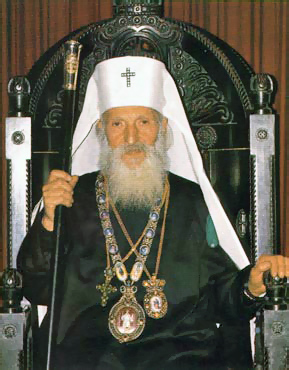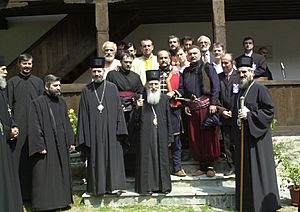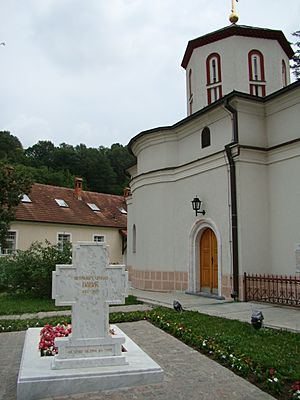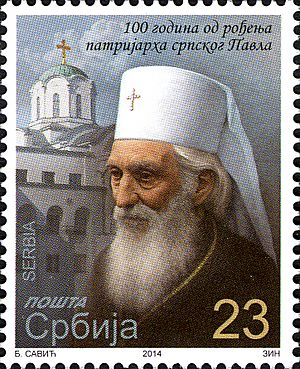Pavle, Serbian Patriarch facts for kids
Quick facts for kids His Holiness Pavle |
|
|---|---|
| Archbishop of Peć Metropolitan of Belgrade and Karlovci Serbian Patriarch |
|

Patriarch Pavle in October 1992
|
|
| Church | Serbian Orthodox Church |
| See | Belgrade |
| Enthroned | 1 December 1990 |
| Reign ended | 15 November 2009 |
| Predecessor | German |
| Successor | Irinej |
| Orders | |
| Ordination | 1948 |
| Consecration | 1957 |
| Personal details | |
| Birth name | Gojko Stojčević |
| Born | 11 September 1914 Kućanci near Magadenovac, Kingdom of Croatia-Slavonia, Austria-Hungary |
| Died | 15 November 2009 (aged 95) Belgrade, Serbia |
| Buried | Rakovica monastery |
| Signature | |
| Styles of Serbian Patriarch Pavle |
|
|---|---|
| Reference style | His Holiness |
| Spoken style | Your Holiness |
| Religious style | Patriarch |
| Posthumous style | His Holiness Patriarch Pavle of Blessed Repose |
Pavle (Serbian Cyrillic: Павле, Paul; 11 September 1914 – 15 November 2009) was the leader of the Serbian Orthodox Church. He served as the patriarch of the Serbian Orthodox Church from 1990 until his death. His full title was His Holiness the Archbishop of Peć, Metropolitan of Belgrade and Karlovci, and Serbian Patriarch Pavle. He was the oldest living leader of an Eastern Orthodox church before he passed away. Due to his health, he spent his last years in a hospital in Belgrade. His duties were carried out by Metropolitan Amfilohije during that time.
Contents
Early Life and Education
Pavle was born as Gojko Stojčević (Гојко Стојчевић) on September 11, 1914. His birthplace was the village of Kućanci in what is now Croatia. He lost both his parents when he was young and was raised by his aunt. After finishing elementary school, Pavle went to a high school in Belgrade. He then studied at a seminary in Sarajevo.
After the seminary, Gojko attended the University of Belgrade. He studied both Theology and Medicine. He later decided to focus on Theology and graduated in 1942.
Life During World War II
During World War II, he found safety in the Holy Trinity monastery in Ovčar. Later, he moved to Belgrade. In 1944, he worked as a teacher for refugee children in Banja Koviljaca. One day, a boy started to drown in the river. Gojko bravely jumped into the cold water to save him. Soon after, he became very ill with a lung condition. Doctors thought he had tuberculosis and only had a few months to live.
He then went to the Vujan Monastery. He lived there away from other monks and managed to recover from his illness. To show his thanks, he carved a wooden cross and gave it to the monastery.
Becoming a Monk
After the war, he worked as a construction worker in Belgrade. Because of his health, he decided to become a monk in 1946. This happened at the Blagoveštenje monastery in Ovčar. His monastic name became Pavle, which means Paul. He served as a hierodeacon (a type of deacon) in Blagoveštenje. Later, he served at Rača monastery from 1949 to 1955.
In 1954, Pavle was ordained as a hieromonk (a monk who is also a priest). The same year, he became a protosyncellus, and in 1957, an archimandrite.
Further Studies and Bishopric
Between 1955 and 1957, Pavle continued his studies in Greece. He attended the Theological School of the University of Athens. He earned a doctorate in New Testament and liturgy. After returning from Greece, he was chosen to be the Bishop of Ras and Prizren in 1957. This area includes all of Kosovo. He served in this important role for 33 years before becoming the Patriarch.
As a Religious Leader
As the Bishop of Ras and Prizren, Pavle helped build many new churches. He also helped repair older ones. He traveled a lot to meet the people in his area. He also wrote books and gave talks on Church music and the Church Slavonic language.
Becoming Serbian Patriarch
After serving for 34 years in Kosovo, Pavle was elected the Serbian Patriarch in 1990. He took over from the previous Patriarch, Serbian Patriarch German, who was ill. Pavle then moved to Belgrade. He was officially made Patriarch in the St. Michael's Cathedral in Belgrade on December 2, 1990. He was also honored at the Patriarchal Monastery of Peć, which is a very old and important place for the Serbian Church, on May 22, 1994.
Role During Difficult Times
During the 1990s, the region faced many challenges. Patriarch Pavle, as the head of the church, played a role in public life. He met with political leaders and also with people who disagreed with the government. In 1993, he wrote a letter asking for the release of a political leader from prison.
The Orthodox Church was seen by some as supporting Serbian people during the conflicts. Patriarch Pavle visited areas where Serbs lived. He aimed to offer spiritual comfort and support to the people during these hard times.
Involvement in Protests
In 1997, Patriarch Pavle joined large protests against the government in Belgrade. On January 27, he led protesters through a police line. This was a clear sign of his disagreement with the government. He later became closer to opposition leaders. He called on the government to take responsibility for the problems in the country and to resign. After a change in government in Serbia, Pavle continued to work with the new leaders. He was often invited to important public events.
Later Years and Legacy
Many people called Pavle the "walking saint" because of his simple life. He was known for his humility. Unlike other bishops, he did not own a car. When asked why, he said he would not buy one until every family in Kosovo had their own car.
During his time as Patriarch, he helped bring together different parts of the Serbian Orthodox Church. He also tried to resolve issues with the church in Macedonia. He traveled to many Serbian Orthodox communities around the world. He visited Australia, the United States, Canada, and Western Europe. He also visited Russia and was a guest at the United Nations Headquarters and the White House.

Patriarch Pavle was the oldest living Patriarch among all Orthodox churches. He deeply admired and often quoted the words of the Apostle Paul. He was named Pavle after him.
In October 2004, Pavle wrote a letter about the elections in Kosovo. He encouraged Serbs to not participate in the voting.
Health Decline
In April 2007, the Holy Synod (the church's governing body) announced that Pavle was recovering in the hospital. His duties were temporarily taken over by Metropolitan Jovan. He was discharged and returned to his duties in May. However, his health worsened, and he used a wheelchair. In November 2007, he was admitted to a medical clinic. Metropolitan Amfilohije Radović was chosen to carry out the Patriarch's duties. In May 2008, the Holy Synod took over all his responsibilities due to his health. In October 2008, Pavle asked to resign because of his declining physical ability. However, the Holy Synod decided he should remain Patriarch for life.
Death and Funeral
Patriarch Pavle passed away on November 15, 2009. He had spent more than two years in the Military Medical Academy in Belgrade. People could pay their respects at the Cathedral Church of St. Michael the Archangel in Belgrade.
His funeral service was held on November 19 outside the Cathedral of Saint Sava. He was laid to rest at Rakovica monastery. Many important religious leaders attended the funeral. These included Ecumenical Patriarch Bartholomew I of Constantinople and Patriarch Daniel of Romania. Political leaders from Serbia and other countries also sent their condolences.
The Government of Serbia declared three days of national mourning. The President of Serbia, Boris Tadić, said that the Patriarch's death was a "great loss for the entire Serbian nation." Many religious and political leaders from around the world sent messages of sympathy.
He was succeeded by Bishop Irinej in January 2010.
Awards and Honors
 Grand Cross of the Order of the Star of Karađorđe (awarded by the Karađorđević dynasty), 2007
Grand Cross of the Order of the Star of Karađorđe (awarded by the Karađorđević dynasty), 2007- Award of the Unity of Orthodox Nations Foundation, 2002
- Order of the Holy Prince Vladimir Equal to the Apostles of the First Degree (ROC), 2004
- Honorary Doctorate of Divinity (SOC), 1988
See also
 In Spanish: Pablo II de Serbia para niños
In Spanish: Pablo II de Serbia para niños
- List of 20th-century religious leaders
- List of 21st-century religious leaders






